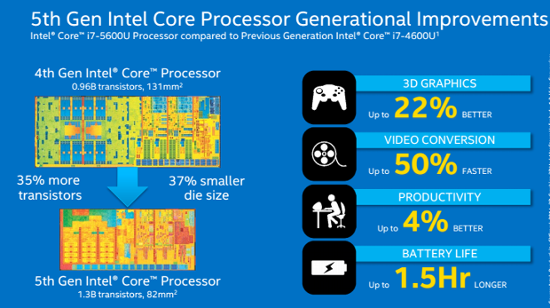It has been a long time coming, but Intel has finally unveiled Broadwell, its next generation of processors, at CES 2015. Using a 14nm process, down from 22nm on last year’s Haswell chips, these faster and more efficient family of processors will power most new mainstream PCs for the next year or so. To be accurate, Broadwell chips are already available in a host of ultraportable computers in the form of Intel’s Core M chips, but this is the first time that the powerful versions are breaking cover.
Broadwell will drive displays that are larger, with resolutions of up to 3200 x 1800 pixels, and machines with longer battery life, more than the 11 hours that we are used to currently. The first of these will come in the guise of lighter dual-core Core i3, i5, and i7 chips, with the beefier quad-core models coming later this year. At CES, Intel unveiled 14 different Broadwell-series chips for laptops and desktops, including 13 15-watt processors with basic Intel HD graphics, and four 28-watt models with more powerful Intel Iris graphics.
Intel says Broadwell’s biggest benefits will not necessarily be felt with longer battery lives. Instead, the biggest gains will be felt in visually intensive tasks; not surprising, considering about two-thirds of the die area is dedicated to graphics. Intel is promising up to a 22 percent improvement in 3D graphics benchmarks, and up to 50 percent faster video-conversion time. The other big benefit is fewer wires. Broadwell chips will support a variety of technologies that dispense with the need for cables and ports, including Intel Wireless Gigabit Docking and the next generation of Intel’s Wireless Display technology, which can now support display resolutions as high as 4K. It also supports Intel’s RealSense depth-sensing camera setup, which allows users to do things like tweaking the focus after a photo has been taken.

